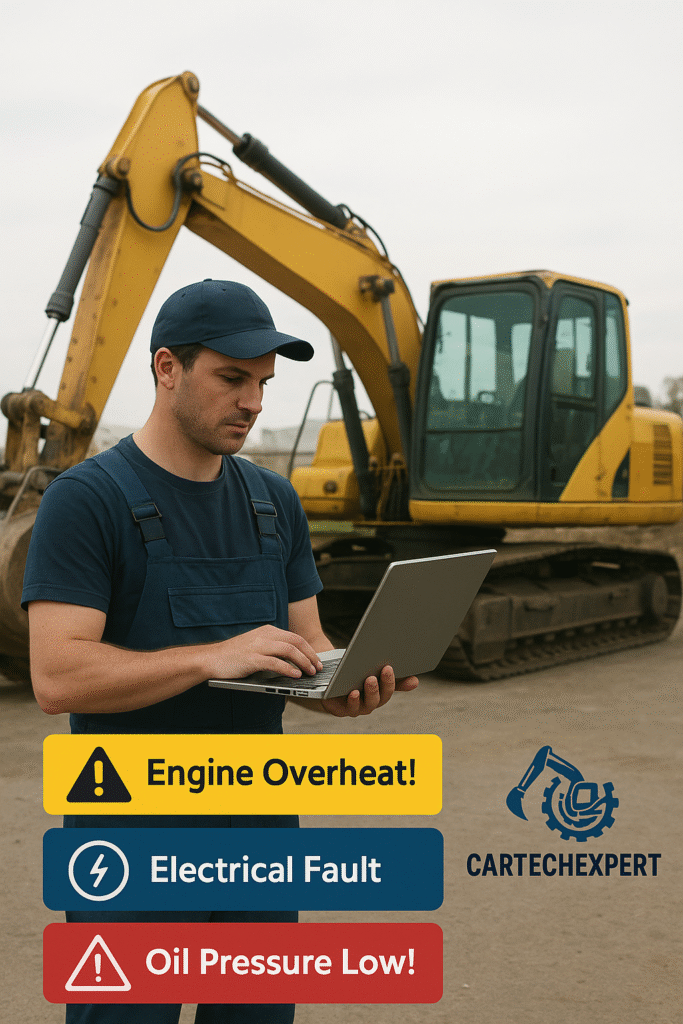Physical Address
Arthur Avenue , BrookField , ILLINOIS , 60513 , United State

Imagine you’re on-site with your equipment running smoothly, and suddenly a red light flashes or a warning code appears on the display. Your first thought is usually—what does that mean, and how serious is it? For many heavy equipment operators and technicians, diagnostic alerts can feel like cryptic messages that disrupt operations. But when you understand how to read and act on them, you can transform those alerts into tools for preventing downtime and improving equipment health.
Every modern heavy machine—from excavators to wheel loaders—comes equipped with onboard sensors and control modules that constantly monitor performance. These sensors track parameters such as oil pressure, hydraulic flow, temperature, fuel efficiency, and emissions. When something moves outside normal operating ranges, the system generates a diagnostic alert.
These alerts can appear as a fault code, warning symbol, or a simple message on the display. Understanding them isn’t just about knowing what’s wrong—it’s about acting at the right time to prevent bigger failures. As equipment becomes more intelligent, so do its diagnostics, allowing you to take a more predictive approach rather than just reacting when something goes wrong.
Ignoring or misinterpreting alerts is one of the main causes of unexpected equipment breakdowns. A simple low-pressure warning can evolve into a catastrophic failure if not handled promptly. You save time, money, and resources by addressing alerts early and accurately.
Diagnostic alerts are categorized by severity and system type. Understanding these helps you prioritize what needs immediate action versus what can be scheduled for later maintenance.
These aren’t faults but helpful notifications—such as “Scheduled Maintenance Due” or “Filter Replacement Recommended.” They help you stay ahead of maintenance schedules.
Warning alerts indicate potential issues that need attention soon. Examples include abnormal fuel consumption or elevated engine temperature.
These require immediate action. Examples: low hydraulic pressure, transmission overheating, or electrical short circuits. Ignoring them can cause total system failure.
Each alert typically includes a fault code (like “E157” or “MID 128 SID 231 FMI 4”). These codes correspond to specific problems in your equipment’s subsystems. To interpret them:
To master fault interpretation, check our earlier post: Common Diagnostic Trouble Codes in Construction Equipment (and What They Mean).
Not all alerts demand immediate action. You must categorize them based on severity, operational impact, and safety. Here’s a simple method:
This prioritization approach helps your team respond efficiently and reduces stress on operators who face multiple alerts at once.
To stay ahead of diagnostic alerts, prevention must be your strategy—not reaction. Here are actionable ways to minimize issues before they escalate:
A fleet operator using a CAT 980M wheel loader once faced repeated “Hydraulic System Overheat” alerts. Instead of replacing the cooling fan motor immediately, the team analyzed fault trends via telematics. They found debris buildup blocking airflow to the cooler. After cleaning and recalibrating, the issue disappeared permanently—saving thousands in unnecessary part replacements.
This example shows that understanding diagnostics leads to smarter, more cost-effective decisions rather than guesswork repairs.
| Alert Type | Example Code | Severity | Recommended Action |
|---|---|---|---|
| Engine Oil Pressure | E157 | Critical | Shut down equipment and inspect lubrication system immediately. |
| Hydraulic Temperature High | MID 128 SID 231 FMI 4 | Warning | Inspect for cooler blockage or low hydraulic fluid levels. |
| Battery Voltage Low | FMI 9 | Moderate | Check alternator and battery terminals for corrosion. |
| Air Filter Restriction | E109 | Low | Clean or replace filter during next maintenance interval. |
Modern fleets are adopting AI-powered telematics systems that combine real-time data with predictive analytics. These systems don’t just tell you what’s wrong—they tell you what will go wrong next. Machine learning algorithms analyze vibration, heat, and performance trends to predict component wear long before failure occurs.
Check out our related post: The Future of Telematics and Diagnostics in Off-Road Vehicles for a deeper dive into how technology is reshaping maintenance planning.
Most alerts are triggered by sensor readings outside normal ranges—often caused by fluid issues, electrical faults, or worn components.
While some codes can be cleared, doing so without addressing the issue can mask serious underlying problems.
For deep-level diagnostics, yes. However, universal tools like Jaltest or TEXA also read and interpret codes across multiple brands.
Telematics platforms allow real-time remote monitoring and predictive analysis, ensuring issues are caught early before alerts appear.
CAT, Volvo, Komatsu, and John Deere have advanced onboard diagnostic ecosystems integrated with AI and cloud systems.
You’ve now learned how to interpret and prioritize diagnostic alerts in heavy equipment. To deepen your understanding, explore these expert resources:
For more insights and professional tools, visit our main site: cartechexpert.com or explore premium diagnostic products and software at our store: store.cartechexpert.com.
Written by CARTECHEXPERT — empowering diagnostic professionals with the knowledge and tools to keep heavy equipment running smarter, longer, and stronger.
